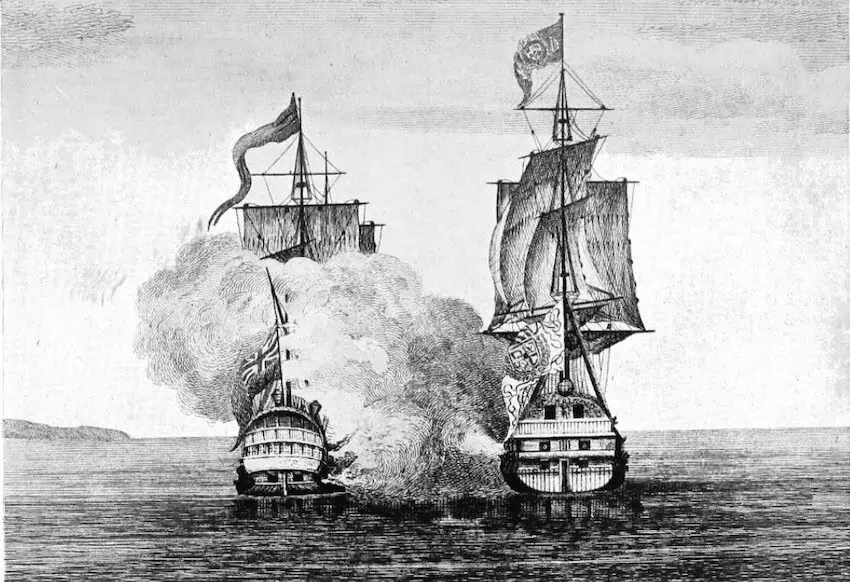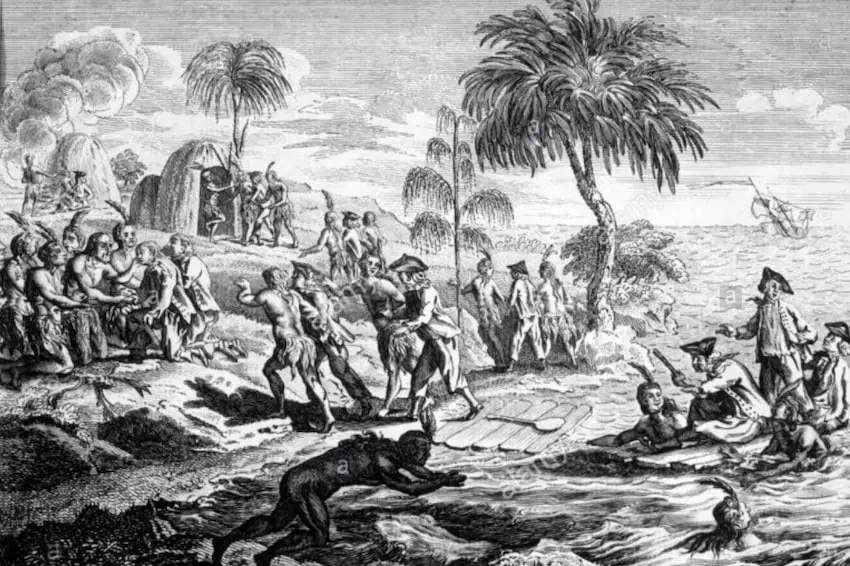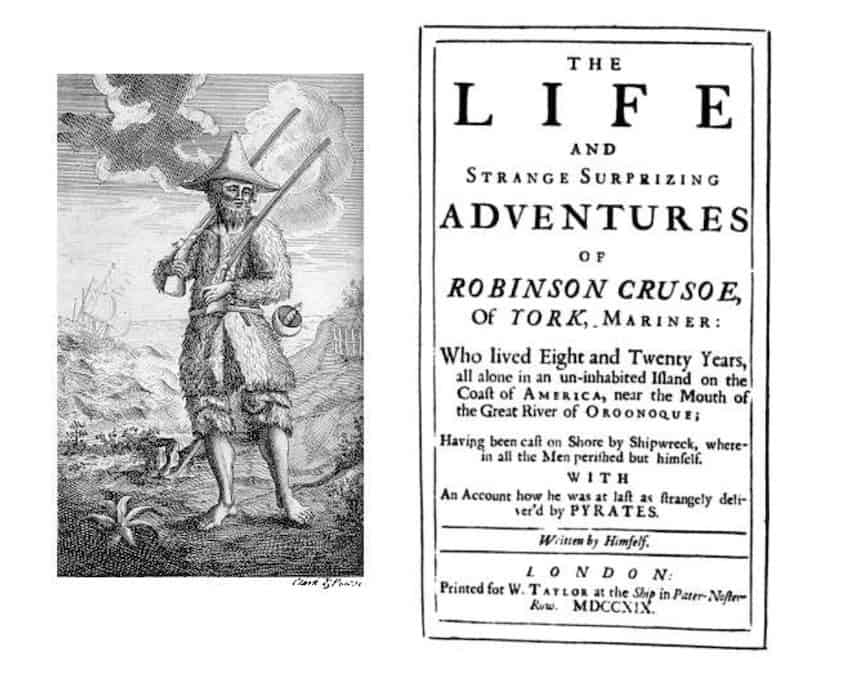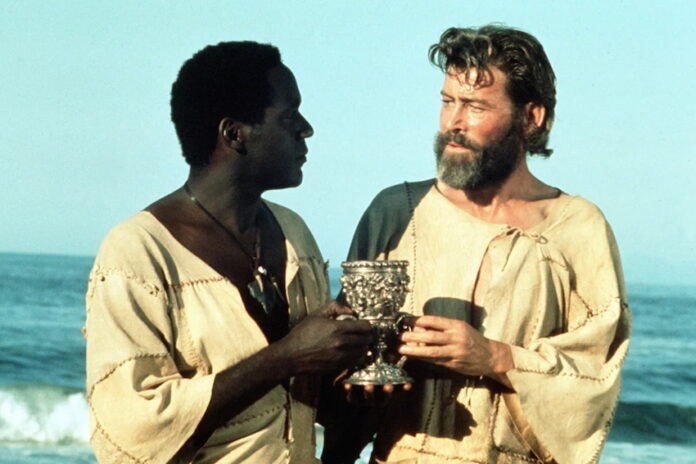When former castaway Alexander Selkirk returned to England in 1711, eight years after he had left, it was with the then-fabulous sum of 800 pounds in his pocket. Now wealthy, Selkirk would also become famous a year later, after the man who had rescued him from his desert island and helped make him rich, Captain Woodes Rogers, published his account of their adventures.
In 1713, Selkirk’s fame got another boost courtesy of writer Richard Steele, who published an interview with Selkirk in the magazine The Englishman about the sailor’s adventures during the four years and four months he spent marooned on Más a Tierra, 400 miles off the coast of Chile. One man who was certainly reading was Daniel Defoe, another prominent writer of the time. Six years later, Defoe would pen what is often called the first novel ever written in the English language: “Robinson Crusoe.” In the 300 years since its first appearance, it has never been out of print.

It should be noted that “Robinson Crusoe” was a fictionalized account that doesn’t exactly match up with Selkirk’s story. Unlike Selkirk, Crusoe was stranded in the Caribbean, not the Pacific; he spent not four but 28 years on his island; and he wasn’t alone for all of it, not after the appearance of the man Friday. But one look at the book’s original frontispiece, with its hero clad in goatskins à la Selkirk, and it was clear that the man who had recently been a public sensation was also a major inspiration for Defoe.
Marooned and rescued
Born and raised as Alexander Selcraig in Scotland, Selkirk, as he came to be known, was a less-than-saintly character who ran away to sea after beating up several members of his family and indulging in what the Church of Scotland judged to be illicit fornication.
Selkirk proved to be a capable navigator, serving as the sailing master aboard the Cinque Ports, one of two ships under the command of Captain William Dampier, whose privateering mission was a legal sanction to attack Spanish ships. Although Dampier was the leader of the expedition, Selkirk answered to Captain Thomas Stradling.
In 1704, after several skirmishes with the Spanish and the two ships being separated, Selkirk decided the Cinque Ports was no longer seaworthy, and he demanded that Stradling put him ashore in the Juan Fernández Islands, a remote archipelago west of Chile.
Once ashore, however, Selkirk changed his mind and begged to be taken back onboard. Stradling mocked him and refused. This was a fortunate occurrence for Selkirk, as it turned out, since he was right about the Cinque Ports’ seaworthiness: she would sink, and her surviving captain and crew would be imprisoned in Peru.

Selkirk and Rogers get rich in Cabo San Lucas
Four years and four months later, in February 1709, three ships commanded by Woodes Rogers would arrive and rescue the barefoot and goatskin-clad Selkirk from his island exile, although he had weathered it well otherwise and was in excellent health. William Dampier, along for this voyage, too, recognized Selkirk. Today, the island where Selkirk was marooned is known as Robinson Crusoe, and another in the archipelago is called Alejandro Selkirk.
Rogers’ mission was much the same as Dampier’s had been previously: find and attack Spanish ships. It was legalized piracy that promised plenty of booty, particularly if they could capture one of the ships that sailed on the Manila galleon route, or Nao de China, as it was known in Mexico. These ships were a key link on what was one of the first global trade routes, traveling annually between Manila in the Philippines and Acapulco. They brought Asian silks, spices and other treasures, many of which would eventually find their way back to Spain.
Naturally, these treasure-laden ships were like catnip to English pirates and privateers, who would hide behind Land’s End in Cabo San Lucas’ bay to await them, since the galleons would typically make their way to the estuary in San José del Cabo to replenish their freshwater supplies before traveling on to Acapulco.
The most lucrative of these attacks occurred in 1587 when Thomas Cavendish sacked the Santa Ana in Bahía Cabo San Lucas. Woodes Rogers and crew, including Selkirk, would write the next great chapter in this ongoing piratical history on Dec. 22, 1709, when they outfought the Nuestra Señora de la Encarnación y Desengaño, which had become separated from her sister ship en route from Manila.
A few days later, the Begoña, a more heavily armed and well-captained galleon, would repulse the English assailants and make her way successfully to Acapulco. But by that time, Rogers’ crew had thoroughly looted the Nuestra Señora, which they renamed the Bachelor, and would sail back to England with Selkirk as sailing master. Their fortunes were assured.

Robinson Crusoe and the Pericues
The attack on the Nuestra Señora is a great pirate tale, but from the perspective of Los Cabos’ history and culture, not the most interesting part of Rogers’ narrative in “A Cruising Voyage Round the World,” the book he wrote about his circumnavigation of the globe. That’s because during the months Rogers, Selkirk, and crew were waiting to attack the galleons, they spent time interacting with the Pericú, the original inhabitants of Los Cabos.
Crucially, Rogers was one of the first to write about these now-culturally extinct people, who had lived on the southernmost part of the Baja California peninsula for about 12,000 years. In 1730, a mission would be founded by Jesuits in San José del Cabo to attempt to Christianize the Pericú, and they would be written about at length by many other sources than the early Spanish and English sailors.
However, Rogers provided a particularly indelible historical portrait of the 300 or so Pericúes then in Cabo San Lucas: “They had large limbs, were straight tall, and of a much blacker complexion than any other people that I had seen in the South Seas. Their hair long, black, and straight, which hung down to their thighs. The men stark naked, and the women had a covering of leaves over their privities, or little clouts made of silk grass, or the skins of birds and beasts.”
He wrote of their chief, whose head was “adorn’d with feathers,” and raved about their skills as fishermen, noting that “we saw no nets or hooks, but wooden instruments, with which they strike the fish very dextrously, and dive to admiration. Some of our sailors told me they saw one of ’em dive with his instrument, and whilst he was under water put up his striker with a fish on the point of it, which was taken off by another that watch’d by him on a bark log.”
They also engaged in an active trade, exchanging knives for the fish the Pericúes so easily and deftly caught. So yes, not only was Robinson Crusoe in Cabo, he’s an example proving the area was a hub of activity long before the modern age of tourism.
Chris Sands is the Cabo San Lucas local expert for the USA Today travel website 10 Best, writer of Fodor’s Los Cabos travel guidebook and a contributor to numerous websites and publications, including Tasting Table, Marriott Bonvoy Traveler, Forbes Travel Guide, Porthole Cruise, Cabo Living and Mexico News Daily. His specialty is travel-related content and lifestyle features focused on food, wine and golf.
